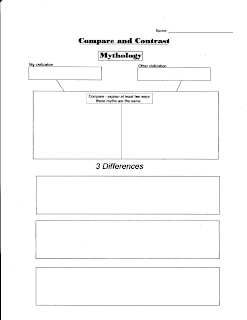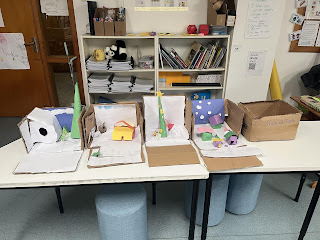Social Studies / Drama / Visual Arts - Toy Theatre for Ancient Civilization Myths
One of the Grade 5 Social Studies Curriculum Ancient Civilizations strand objectives is that students compare and respond to myths and legends from two or more early civilizations. To achieve this end, the class was separated into six different groups for paper theatre. Six creation myths were chosen from The Big Myth, including creation myths from Ancient China, Ancient Greece, Ancient Egypt, Ancient Babylon, Aztec and Maya. Given that students had only done two introductory classes on Ancient Civilizations, and many were not knowledgeable about the individual civilizations, I also included short descriptions of them.
Myths were paired, if they contained three or more similar elements/themes/events/characters. The day the activity was launched, students were given instructions, put into groups and given an envelope containing their myth, and a props/backdrop/characters graphic organizer. Before students could receive their art kit, they had to read through the myth and fill in the graphic organizer.
Once groups had the art kit, they had to make puppets, backdrops, props and a stage (using shoe boxes they had brought in). All of these were to be used for a final performance. Groups had a number from one to three, and a letter from A to C on their envelope. If a group had 1A (Maya) they were going to perform for 1B, 2A was performing for 2B and 3A for 3B. On the day of the performances, students were given a reminder of good audience behaviour. After each performance, the audience was to fill in two stars and a wish for the performing group. After both groups had presented, students were required to complete a compare and contrast sheet for those myths.
The performances went well, however, students were initially not filling in the compare and contrast sheet correctly. Despite having been given the success criteria, which clearly stated that they were to compare and contrast the two myths, many students instead wrote about the performances or the civilizations. While comparing and contrasting civilizations is also an objective of the Ancient Civilizations strand, this was not what they were expected to do.
After enquiring with my associate teacher, she stated that many of the students were not really paying attention, when watching the myths. I also realized, that perhaps I should have suggested that students write jot notes, to aid them in the compare and contrast process. However, since it was a performance, I wanted students to enjoy it the first time. From a classroom management standpoint, it was also difficult to monitor student attention when performances were occurring in three different areas of the room. Were I to do this activity again, I would remind students about the importance of paying attention, and direct them to write jot notes during the performance.
It was becoming clear that without intervention, most students would do poorly on the compare and contrast. At recess, I photocopied enough copies of the myth to distribute a copy of both their own myth and the myth they had just viewed, to each student. While students need to have some responsibility for their own learning, I felt that perhaps my teaching strategy was (in part) at fault for their lack of proper execution. The success criteria was also not co-constructed, which I've since realized is often necessary for certain students to feel that they clearly know what the teacher is looking for. The compare and contrast was assigned as homework, and handed in the Monday following. Several students revised their work, and submitted a more high quality compare and contrast, after those issues arose and they were subsequently given copies of the myths with reiterated expectations.
This activity led to amazing performances and art (which can be viewed below the cut), however there were still some bumps in the road when I implemented the final compare and contrast. I would characterize my experiences with toy theatre as being both reflective of Commitment to Students and Student Learning and Professional Practice. Toy theatre ignited the imaginations of students and had them working collaboratively to create artistic performances. Students were excited to learn through the fusion of drama, visual arts and social studies. There were certain aspects that were challenging, which required instructional and student reflection, in order to respond to the needs of the students.
Myths were paired, if they contained three or more similar elements/themes/events/characters. The day the activity was launched, students were given instructions, put into groups and given an envelope containing their myth, and a props/backdrop/characters graphic organizer. Before students could receive their art kit, they had to read through the myth and fill in the graphic organizer.
Once groups had the art kit, they had to make puppets, backdrops, props and a stage (using shoe boxes they had brought in). All of these were to be used for a final performance. Groups had a number from one to three, and a letter from A to C on their envelope. If a group had 1A (Maya) they were going to perform for 1B, 2A was performing for 2B and 3A for 3B. On the day of the performances, students were given a reminder of good audience behaviour. After each performance, the audience was to fill in two stars and a wish for the performing group. After both groups had presented, students were required to complete a compare and contrast sheet for those myths.
The performances went well, however, students were initially not filling in the compare and contrast sheet correctly. Despite having been given the success criteria, which clearly stated that they were to compare and contrast the two myths, many students instead wrote about the performances or the civilizations. While comparing and contrasting civilizations is also an objective of the Ancient Civilizations strand, this was not what they were expected to do.
After enquiring with my associate teacher, she stated that many of the students were not really paying attention, when watching the myths. I also realized, that perhaps I should have suggested that students write jot notes, to aid them in the compare and contrast process. However, since it was a performance, I wanted students to enjoy it the first time. From a classroom management standpoint, it was also difficult to monitor student attention when performances were occurring in three different areas of the room. Were I to do this activity again, I would remind students about the importance of paying attention, and direct them to write jot notes during the performance.
It was becoming clear that without intervention, most students would do poorly on the compare and contrast. At recess, I photocopied enough copies of the myth to distribute a copy of both their own myth and the myth they had just viewed, to each student. While students need to have some responsibility for their own learning, I felt that perhaps my teaching strategy was (in part) at fault for their lack of proper execution. The success criteria was also not co-constructed, which I've since realized is often necessary for certain students to feel that they clearly know what the teacher is looking for. The compare and contrast was assigned as homework, and handed in the Monday following. Several students revised their work, and submitted a more high quality compare and contrast, after those issues arose and they were subsequently given copies of the myths with reiterated expectations.
This activity led to amazing performances and art (which can be viewed below the cut), however there were still some bumps in the road when I implemented the final compare and contrast. I would characterize my experiences with toy theatre as being both reflective of Commitment to Students and Student Learning and Professional Practice. Toy theatre ignited the imaginations of students and had them working collaboratively to create artistic performances. Students were excited to learn through the fusion of drama, visual arts and social studies. There were certain aspects that were challenging, which required instructional and student reflection, in order to respond to the needs of the students.














Comments
Post a Comment